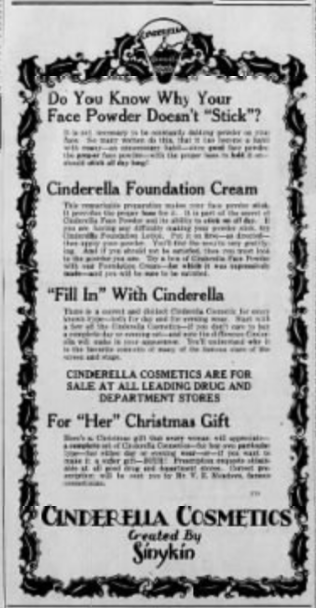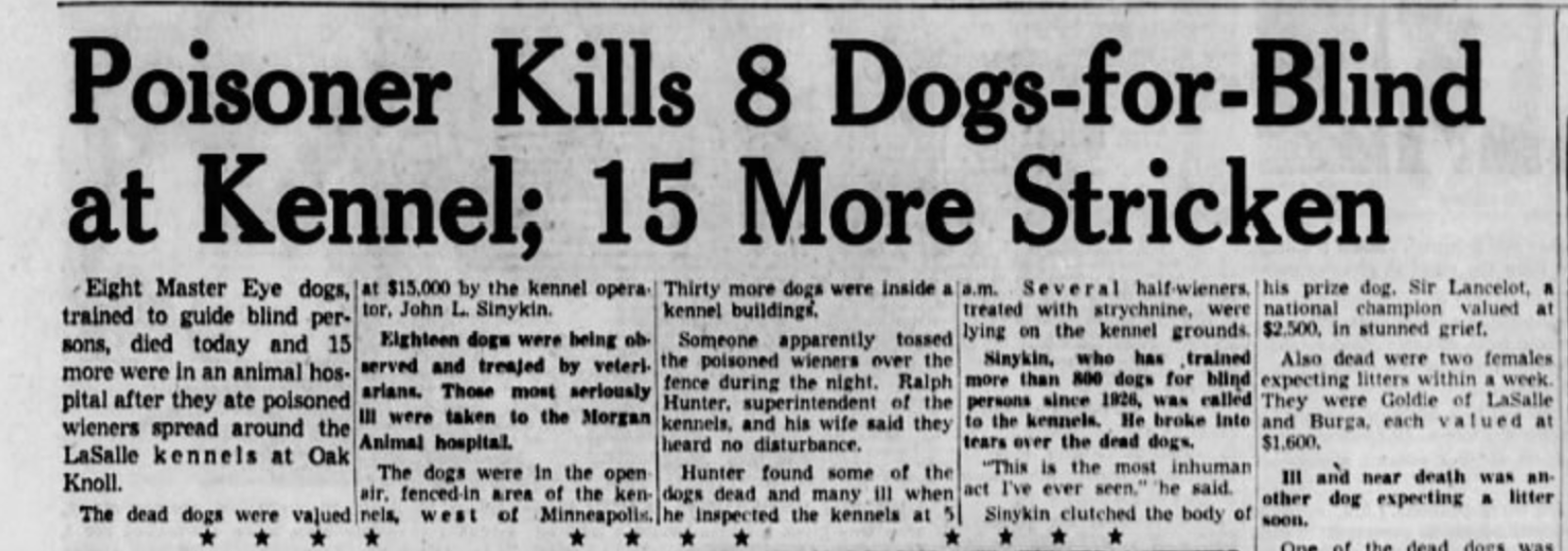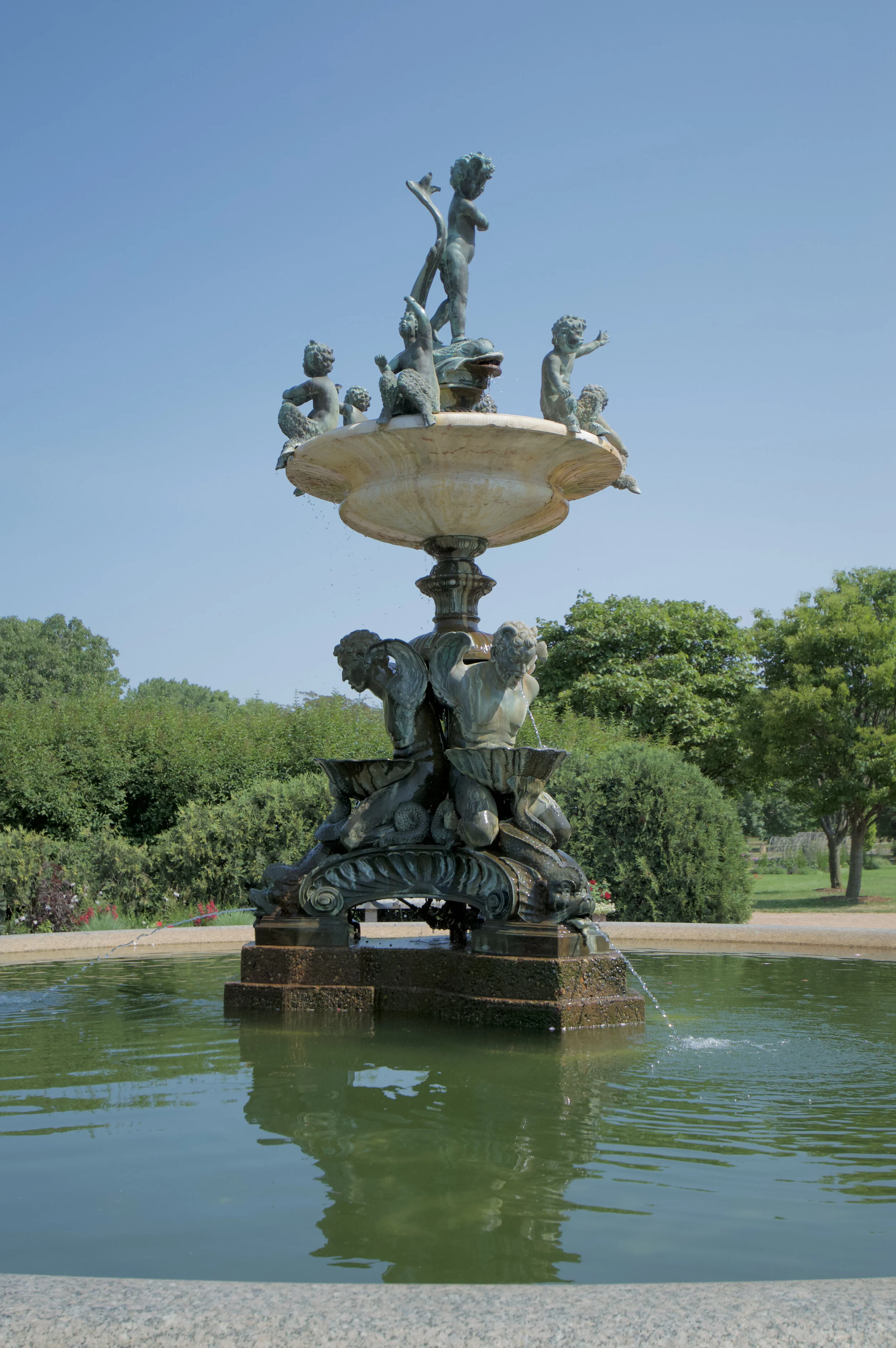The Goodest Boy of Linden Hills
If I see a guide dog, service dog, therapy dog (or any dog really, but ESPECIALLY these) I want to stop and pet it SO BADLY! You’re not supposed to, and I don’t, but boy does it just make me feel so warm and fuzzy seeing little fur babies living their best lives and helping their humans.
The other day, as I was doing research on another topic, I was surprised to discover that the first guide dog in the United States lived in Linden Hills! That’s right! The very first dog trained to assist a blind person in the US of A lived with their owner just on the edge of Lake Harriet. Lets learn more!
The Seeing Eye
Generally, credit for the first American guide dog goes to a training facility in Morristown, New Jersey called The Seeing Eye.
The history of The Seeing Eye began in Europe in the 1920s when American Dorothy Harrison Eustis partnered with Elliott S. "Jack" Humphrey to train and develop their own scientific approach to breeding and training police dogs. In 1927, Eustis wrote an article called "The Seeing Eye." Morris Frank, a 19-year-old blind man from Nashville, Tennessee, was read the article and contacted Eustis. In April 1928, Frank met his first guide dog, named Kiss. Too embarrassed to call out “Come, Kiss”, he changed her name to Buddy and named all his future Seeing Eye dogs (he had six in total) Buddy. Since 1929, more than 16,000 partnerships have been created between dogs from The Seeing Eye and people who are blind and visually impaired.
But Minnesota has them beat!
The Master Eye
John L. Sinykin was at a train station one day when a blind WWI veteran was finding his way to the exit after getting off a train. Sinykin was alarmed by the fact that the man was alone, navigating new territory. (At that time, most blind people stayed home. If they needed to go somewhere, they waited until a family member could escort them. Canes did not come into use until the 1920s and ‘30s.)
Sinykin’s background was not in dogs or training. In fact, he ran a successful cosmetics company based in Saint Paul. Cinderella Cosmetics hired Hollywood makeup artists to tour the country giving makeup demonstrations. When John Sinykin threw a party to open his new factory and offices in 1930, some two thousand people attended the grand opening. The success of this business eventually provided the seed money for starting his nonprofit organization, The Master Eye Foundation.
Working through governmental channels Sinykin brought a German Shepherd to the United States. That dog was Lux of La Salle, the first guide dog ever brought to the United States. The year was 1926 - two years BEFORE Eustis brought over a dog for Morris Frank.
But who would be paired with Sinykin’s dog?
Senator Schall
Thomas Schall was a Minneapolis attorney. In 1907, Schall was assigned to a trial in Fargo, North Dakota. During a break, Schall used a newly-installed electronic cigar lighter at the courthouse. The lighter exploded in flames. Thinking he got lucky with just a few minor burns and blurry vision, he returned to court to finish the trial.
Over the course of the next year, Schall gradually lost all of his vision. His wife, Margaret, stepped in to be his secretary and provide additional help as he needed.
In 1913, Schall decided to run for office. He successfully won a seat in the House of Representatives, becoming the first blind Congressman. In office, he petitioned for and received a young man to be his page - accompanying him everywhere and reading documents to him when he was on the House floor. In 1924, Schall was elected to the Senate.
The Perfect Match
John Sinykin carefully considered who would be the best handler for Lux. Seeing Senator Schall’s need and the publicity that such a pair would bring to his kennels, Sinykin approached Schall in Washington. Senator Schall was skeptical at first, but soon visited the training kennel in Wayzata. Lux soon proved his worth and was adept at getting Schall to his office, the Senate chamber, and the Capitol’s barbershop. The two became inseparable.
Senator Schall lived with his wife in Linden Hills. They bought the Van Tuyl mansion, which was built in 1897. The home, which had a tennis court and stables, was designed by Harry Wild Jones. Jones had also designed the Pagoda-style pavilion at Lake Harriet in 1891.
In 1933, Senator Schall traveled to Montana for a funeral. He didn’t take Lux with him and when he returned after five days, he learned that Lux had died. Senator Schall was beside himself. When he returned to Washington, he asked permission to eulogize Lux from the Senate floor so that it would become part of the public record:
“For this strange division from me, he knew no reason or cause. No question that sorrow killed him. No doubt that he was the victim of mourning and love for me. Lux was so completely mine. …None but the blind will understand the whole of what I mean…”
La Salle Kennels
Sinykin found worldwide success through his breeding and training programs at La Salle Kennels in Wayzata. Throughout a career that spanned more than 50 years, Sinykin bred more than 32 Champion German Shepherds. One of his dogs, Flash of La Salle, was even a stand-in for the popular TV show, “Rin Tin Tin”, in the 1950s.
But owning a kennel was also problematic. The town of Wayzata had to mediate with Sinykin about noise complaints from neighbors. Most of the time the issues could be resolved. However, in 1954, someone tossed poisoned meat into the kennels. Ten of the dogs died of poisoning. Sixteen more required the careful watch of the vet. Community reaction was strong, and there was an outpouring of sympathy sent to Sinykin for his loss. The police canvassed the area and conducted at least 550 interviews, but no person was found.
Sinykin continued to breed and train dogs well into his 90s until his passing in 1983.
The Lux Legacy
Today there are more than 10,000 guide dogs working in the United States. It’s really moving to think how far we’ve come in assisting people with disabilities to live normal, active lives (although we certainly can do more). How wonderful to think that that cause was advanced right in our own neck of the woods, on the shores of Lake Harriet. Next time you’re walking around the lake and see a doggo, think of Lux and what a good boy he was.
















